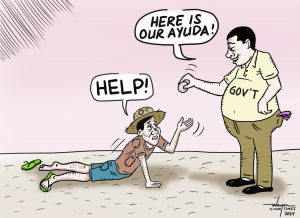So the Cities of Davao, Tagum and IGaCoS in the Southern Mindanao Region are among the local government units in the Mindanao Island Cluster that are in the top 5 list entered in the finals for the Tourism Champion Challenge (TCC) competition? The other two are Surigao and Basilan Provinces.
The competition of sort was organized by the Department of Tourism last February. Its intention is to make tourism industry “an economic driver of the country, as well as to incentivize the tourism development of cities, provinces and municipalities in the Philippines.”
According to Noel Dacquioag, the provincial tourism officer of Davao del Norte, the chosen LGUs in the country’s three island clusters “will undergo capability building as well as enhancement in their technical skills on different tourism-related project implementation.”
Indeed it is very welcome news that of the five who made it to the top of the list for the Mindanao cluster, three LGUs are from the Davao Region. People in the three Southern Mindanao cities have every reason to be proud of such an exceptional feat.
But there is something that those who chose Tagum and IGaCoS to become part of the top 5 list may have missed out in their determination. The two LGUs have one critical service that is so wanting if they want tourism to become a major economic driver in these areas.
We refer to the quality and stability of the power supply prevailing in the two LGUs. The poor service has been publicly manifested by the two cities’ residents, its officials and most of all by the businessmen thereat.
This unresolved almost daily power outages in the island city and in the provincial capital as well as the rest of the Province of Davao del Norte has become a major bane in maximizing the development of the two cities’ tourism industry.
Yes, the capability building and enhancement of technical skills in implementing tourism-related projects may largely help the cities’ tourism stakeholders. But how can such enhanced capabilities and skills be put to the maximum utilization when one of the most important services that is needed to make the two cities physically ready for the tourists’ enjoyment is very much wanting?
Purchase of power generators to add to the shortage from the lack of such from the power retailer is surely only a palliative. Therefore, its sustainability could only be on a limited period of time.
Then how will local tourism establishment owners reckon with tourists complaining of high decibel noise in areas where generating sets are operated when power interruptions occur?
************************
This one project is for the books.
We are referring to a water supply system set up in a remote sitio in Banarao, Talandang, Tugbok District in Davao City. The project was initiated under the LTF-ELCAC program of the military to reward once rebel-controlled communities that have shown significant decimation of the anti-government forces.
According to some barangay officials we have talked to recently, the water system – an electric powered deep well sourcing of potable water – was implemented in the remote village more than a year ago. The deep well would have been the source of safe drinking and household use water for the people living in the area that is several kilometers away from the nearest water line of the Davao City Water District (DCWD).
The barangay officials told us that the budget allocated by the LTF-ELCAC for the project was barely enough for the materials and labor needed to complete the water system. Unfortunately, perhaps because of lack of planning, proper consultation and maybe because of the implementing agency’s lack of familiarity of the place, its people did the project in an area far from the power line and the road.
The machine intended to pump the water out from down under requires a transformer that is devoted only for its use. Moreover, according to the barangay officials, the well’s location from the nearest primary power line requires several poles with which to string the electric wires.
An estimate of expenses provided by Davao Light for the line extension, stringing, the poles and the transformer, the officials told us, is over half a million pesos. It was not in the budget released by the LTF-ELCAC for the water system to operate.
If the project is to be operational in order to serve its purpose, then the amount needed to provide the electricity requirement must be shouldered by whom? Without doubt the barangay cannot afford it; nor will the power firm give it for free. Therefore, the City Government of Davao must come to the rescue. Otherwise the water supply project in an area once the hotbed of insurgency and movement backers by intimidation will just be another monument of government wastage and neglect.
We call on the local LTF-ELCAC representatives to look into the said project and do whatever is necessary to make it work. Or, was it done intentionally for some reason they alone knew?

